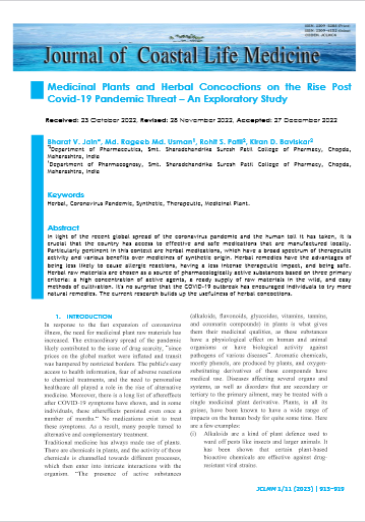Medicinal Plants and Herbal Concoctions on the Rise Post Covid-19 Pandemic Threat – An Exploratory Study
Main Article Content
Abstract
In light of the recent global spread of the coronavirus pandemic and the human toll it has taken, it is crucial that the country has access to effective and safe medications that are manufactured locally. Particularly pertinent in this context are herbal medications, which have a broad spectrum of therapeutic activity and various benefits over medicines of synthetic origin. Herbal remedies have the advantages of being less likely to cause allergic reactions, having a less intense therapeutic impact, and being safe. Herbal raw materials are chosen as a source of pharmacologically active substances based on three primary criteria: a high concentration of active agents, a ready supply of raw materials in the wild, and easy methods of cultivation. It's no surprise that the COVID-19 outbreak has encouraged individuals to try more natural remedies. The current research builds up the usefulness of herbal concoctions.
Article Details
References
Berman, J.D.; Straus, S.E. Implementing a research agenda for Complementary and Alternative Medicine. Annu. Rev. Med. 2003, 55, 239–254.
Leigh-de Rapper, S.; van Vuuren, S.F. Odoriferous therapy: A review identifying essential oils against pathogens of the respiratory tract. Chem. Biodivers. 2020, 17, e2000062.
Lv, F.; Liang, H.; Yuan, Q.; Li, C. In vitro antimicrobial effects and mechanism of action of selected plant essential oil combinations against four food-related microorganisms. Int. Food Res. J. 2011, 44, 3057–3064.
Kon, K.; Rai, M. Antibacterial activity of Thymus vulgaris essential oil alone and in combination with other essential oils. Nusantara Biosci. 2012, 4, 50–56
de Rapper, S.; Kamatou, G.; Viljoen, A.; van Vuuren, S.F. The in vitro antimicrobial activity of Lavandulaangustifolia essential oil in combination with other aroma-therapeutic oils. Evid.-Based Complement. Altern. Med. 2013, 2013, 852049.
Honório, V.G.; Bezerra, J.; Souza, G.T.; Carvalho, R.J.; Gomes-Neto, N.J.; Figueiredo, R.C.B.Q.; Melo, J.V.; Souza, E.L.; Magnani, M. Inhibition of Staphylococcus aureus cocktail using the synergies of oregano and rosemary essential oils or carvacrol and 1,8-cineole. Front. Microbiol. 2015, 6, 1223.
Orchard, A.; Kamatou, G.; Viljoen, A.M.; Patel, N.; Mawela, P.; van Vuuren, S.F. The influence of carrier oils on the antimicrobial activity and cytotoxicity of essential oils. Evid.-Based Complement. Altern. Med. 2019, 2019, 6981305.
Darwish, R.S.; Hammoda, H.M.; Ghareeb, D.A.; Abdelhamid, A.S.A.; Naggar, E.M.B.E.; Harraz, F.M.; Shawky, E. Efficacy-directed discrimination of the essential oils of three Juniperus species based on their in-vitro antimicrobial and anti-inflammatory activities. J. Ethnopharmacol. 2020, 259, 112971.
Siju, E.N.; Rajalakshmi, G.R.; Vivek, D.; Aiswarya Lakshmi, A.G.; Mathew, S.; Joseph, M.K.; Sabita, P.V. Anti-inflammatory activity of Pimentadioica by membrane stabilization method. Int. J. Phytopharm. 2014, 5, 68–70.
Carrasco, A.; Martinez-Gutierrez, R.; Tomas, V.; Tudela, J. Lavandin (LavandulaintermediaEmeric ex Loiseleur) essential oil from Spain: Determination of aromatic profile by gas chromatography–mass spectrometry, antioxidant and lipoxygenase inhibitory bioactivities. Nat. Prod. Res. 2016, 30, 1123–1130.
Rodrigues, L.B.; Oliveira Brito Pereira Bezerra Martins, A.; Cesário, F.R.A.S.; Ferreira e Castro, F.; de Albuquerque, T.R.; Martins Fernandes, M.N.; Fernandes da Silva, B.A.; QuintansJúnior, L.J.; Martins da Costa, J.G.; MeloCoutinho, H.D.; et al. Antiinflammatory and antiedematogenic activity of the Ocimumbasilicum essential oil and its main compound estragole: In vivo mouse models. Chem. Biol. Interact. 2016, 257, 14–25.
de Veras, B.O.; de Oliveira, J.; de Menezes Lima, V.L.; do AmaralFerraz Navarro, D.M.; de Oliveira Farias de Aguiar, J.; de Medeiros Moura, G.M.; da Silva, J.W.; de Assis, C.; Gorlach-Lira, K.; de Assis, P.; et al. The essential oil of the leaves of Verbesinamacrophylla (Cass.) S.F. Blake has antimicrobial, anti-inflammatory and antipyretic activities and is toxicologically safe. J. Ethnopharmacol. 2021, 265, 113248.

